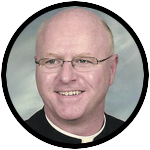
Msgr. Joseph Prior
(See the readings for the 21st Sunday in Ordinary Time, Aug. 27)
St. Peter’s Basilica in Vatican City, Rome, is a grand church built over the tomb of St. Peter the Apostle. The current structure is actually the second church built on the site; the first St. Peter’s Basilica on the site was built by Constantine in the fourth century. Prior to this there was a cemetery there, and still is, underneath the current construction.
If you visit the basilica you can take a tour of the cemetery, which is called the “necropolis.” It is here that St. Peter is buried. The location is not visible from inside the main level of the basilica but is directly beneath the dome and altar. Looking up, from this level, a visitor will see the following words are written in Latin at the base of the dome: “You are Peter and on this rock I shall build my Church … I will give you the keys of the kingdom of heaven.”
Throughout the history of the church, the faithful have venerated the apostle who is buried here. One of the old traditions for a pilgrim visiting the basilica for the first time is to go to the area in front of the altar and to recite the creed. In other words, they make a profession of faith in continuity with the profession of faith that St. Peter made in Christ Jesus. We are reminded of this profession of faith in this Sunday’s liturgy.
[hotblock]
Peter says: “You are the Christ, the Son of the living God.” He makes this profession of faith in Jesus in response to his question: “But who do you say I am?” Just previously he had asked the disciples: “Who do people say the Son of Man is?” The disciples responded to the question by saying: “… John the Baptist, others Elijah, still others Jeremiah or one of the prophets.”
Surely Jesus is a prophet (one who speaks for God) but he is so much more. His identity is not limited to being a prophet. Hence Jesus asks the second question directed to the disciples. Though the question is directed to all the disciples there, it is Peter who gives the response. Jesus is the “Christ” (which is the Greek translation for “messiah” or “anointed one”) and the “Son of the living God.”
This question of Jesus’ identity has come up recently in our liturgies. A few weeks ago we celebrated the Transfiguration. A similar theme emerged from that event. Peter, James and John were with Jesus when he was transfigured. Moses and Elijah appeared with him. Peter’s response at that time was an offer to build three tents: one for Moses, one for Elijah and one for Jesus. In doing so Peter was putting Moses and Elijah on the same plane as Jesus. It is at this point that the voice of the Father comes from the cloud and says: “This is my beloved Son, listen to him.”
Now Peter makes the profession of faith sometimes called a “confession” of faith. Jesus sees the Father at work in Peter’s response. Of all the disciples it was Peter who could make the proper response and identification. God has blessed him for a special role and so Jesus says those words to Peter that are written at the base of Michelangelo’s dome.
Peter’s profession of faith, made in words, reflects an interior belief in Jesus that permeates his life. Surely this belief needs to be developed as we will see in next week’s Gospel, but the core is there, and Peter’s life is changed because of it. As his relationship with and understanding of Jesus develops, Peter’s life has new meaning and purpose. He begins to recognize the depth of love and mercy that God has for him and all God’s people.
We are invited to have that same experience. Every Sunday when we gather to celebrate the Mass, we celebrate God’s love and mercy. While the entirety of this celebration is a profession of faith, we do make a particular “profession of faith” when we, as a communion, recite the Creed (which comes from the Latin “credo” or “I believe”). The words we say are a public manifestation of our belief. When said from the “heart,” they have the ability to lead us, more deeply, to the mystery of life in Christ Jesus that we live every day.
The Gospel this Sunday invites us, once again, to be drawn into the love of God through faith and to make Peter’s words our own: “You are the Christ, the Son of the living God.”
***
Msgr. Joseph Prior is pastor of Our Lady of Grace Parish, Penndel, and a former professor of Sacred Scripture and rector of St. Charles Borromeo Seminary.
PREVIOUS: When the silence of God meets our life’s unfinished symphony
NEXT: The sacred act of dishwashing



Recognizing Jesus as Lord is only step 1. Consecrating ourselves directly to Him is step 2. This is when we surrender and cast all of our care on Him.